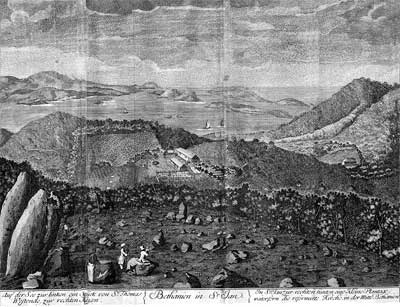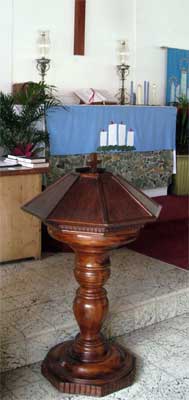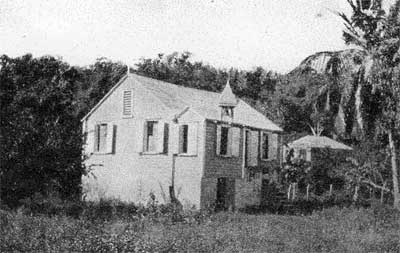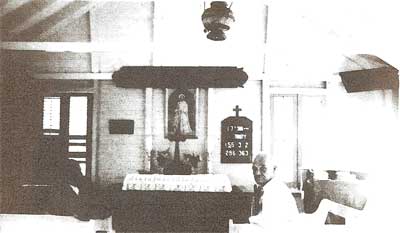A Visit to the Bethany Moravian and the Nazareth Lutheran Churches, December 13, 2008
In December SJHS members joined Rudolph ‘Pimpy’ Thomas, Reggie Callwood, and Elroy Sprauve for on-site history lessons about two of our spiritual and architectural gems on St. John, the Bethany Moravian Church and the Nazareth Lutheran Church.
BETHANY MORAVIAN CHURCH AND MISSION HOUSE
According to The St John Drum in an October 18, 1974 article by Vernon J. Nelson, Archivist at the official Moravian Church Archives in Bethlehem, Pennsylvania, the first Moravian Mission anywhere in the world was in the Virgin Islands. A Lutheran nobleman, Count Nicolai Louis von Zinzendorf, encouraged/persuaded the Moravian Brethren to extend their Christian influence to the West Indies. Through the quaint Moravian practice of drawing lots, a Lutheran layman and potter, Leonard Dober, and a Moravian carpenter, David Nitschmann, were sent to the West Indies with the blessing of Danish princess Charlotte Amalie. Early Moravian missionaries were tradesmen; they were expected to support themselves in addition to ministering to the enslaved.

Bethany and Pastory, ca. 1770
The early Moravian brethren had a horrific time of it. The basic history of the early years of the Moravian Church written by CGA Oldendorp in 1777 (translated), gives a grueling blow by blow. G.G. Oliver Maynard calls the history of planting the Moravian Church on 18th century Virgin Islands, with the hurricanes, famines, political and social travails, wars and illnesses an ‘18th and 19th century Acts of the Apostles.’ Mr. Thomas read briefly from the “Moravian Church’s 200th Anniversary Booklet” (published Sunday June 27, 1982) which also recounted some of those travails.[1]
On St. John the Moravians did not prosper at first, due to the 1733 slave uprising. Moravian work truly began on St. John in 1741 at the initiation of the pious overseer of the Tonis plantation, Jens Rasmus. The first baptism took place in 1745; a cotton estate, Bethania, was purchased in 1749. Also in 1749 a Brother Cornelius was baptized a Moravian; he was a master mason, missionary, and accomplished linguist. It was he who laid the foundations of six churches and mission houses, including those at Bethany. The first full-time pastor Johann Schur arrived in late 1749, but died of fever on January 5, 1750. The first resident missionary Bro. Johann Brucker, was stationed here in 1754.[2]
In the 1840’s unconditional baptism of infants was practiced; only one of the parents had to belong to the Brethren’s church. This coincided with the introduction of compulsory education for slaves, on the presumption that education would make possible a Christian upbringing of the slave children [2]. In the 1840s the Moravians were selected to run the schools at Emmaus, Bethany and elsewhere, enlarging the Moravian opportunity. Moravians lent encouragement to the slaves to prepare themselves for the assumption of responsible positions within the church hierarchy and community.[3]
In 1860 the restriction of baptizing only ‘legitimate’ children was introduced, causing parents to go to other churches for baptism. This stricture caused the loss of nearly half the Brethren’s membership over 20 years and eventually the 1848 regulation was restored. ([2]p. 72, after Lawaetz, Brod, Mis)
It was admittedly hard to focus on the difficult history of the Moravian and Lutheran missions while in the company of such engaging and good-humored story-tellers, who recounted more recent life events in their churches. When Mr. Thomas was school-age, there was a two room school held in the Bethany Hall on the ground floor. (There was also an upper floor then). The teachers were strict, dedicated to all students’ learning, “one way or another, and regardless of their scholarly interests,” as Pimpy remembers. “Clarice Thomas could tell you who sneezed, and you NEVER crossed her on days she wore her hair plaited” Apparently a single glance from Ms. Thomas could remind you to hand pump the organ faster.
On really rainy days, school might be let out early, Pimpy reports, ‘‘so we learned to brush up against the trees ‘accidentally’ to wet our clothes on the way to school.” The Moravian tradition of learning life skills accompanied by class work prevailed—Learning to fish accompanied learning to swim, learning to read and memorize accompanied performing skits and making decorative ‘flowers’ out of century plant tips for holiday presentations. Reggie recalls wanting to join a church that was closest to the Methodist Church. The Methodists and Moravians often shared ministers, and his wonderful tenor voice was in demand… by many churches.
Portions of the Bethany buildings have been rebuilt several times. In 1793 and in 1819, various structures were rebuilt after they were carried away by hurricane. Maintenance of the church has remained a priority of its members, and the grounds have not been abandoned since establishment. In 1904, at the 150th anniversary of the St. John Moravian mission, a new belfry and bell were dedicated (St John Drum, September 19, 1975). In 1919 the belfry was replaced. In the 1960s Reggie replaced the wood floor.
On January 31, 1975 The Drum reported that the Old Bethany Church had a new roof and was being painted and redecorated while parishioners awaited the arrival of new pews. The Drum says, “Undaunted by winds and showers, some 30 visitors joined Mr. Herbert Samuels and Miss Clarice Thomas for a walking tour of the Bethany Church buildings and grounds. The visit was sponsored by the St. John Historical Society, and visitors were much interested in the solid old walls now surmounted by a new roof of the historic church, and in the rubble masonry of the mission house which formerly served as a school. They followed the path down to the graveyard, and read inscriptions on many of the gravestones, some more than 200 years old.” On Friday January 31, page 15 of The Drum reported that Reverend Willard Prout, Pastor and Bishop Hastings dedicated the renovated church. (Please see our website for “History of the Moravian Church” by Willard Prout–Notes presented to the St. John Historical Society, Sunday March 20, 1977 at Emmaus. It contains a short pre-Bober/Nitschmann history and a Recommended Reading List.)
Because of the rain this year (Are we less hardy souls in 2008?), we did not descend to visit the two cemeteries on the grounds. The older cemetery is primarily the resting place of members of the early mission families, as it was customary to bury laborers on the estates where they resided; missionaries seemed to pass on as fast as they came to the VI. The more recent burials are closer to the Church.
NAZARETH LUTHERAN CHURCH AND HALL

The Nazareth Lutheran Church building in Cruz Bay was not built in 1720, the date over the door, although that is the date of the establishment of the Nazareth Lutheran Congregation began Mr. Elroy. Lutheran work on St. John began in 1717, when St. John was annexed to Denmark and ‘joined with St. Thomas as one unit for government administrative purposes. The Lutheran parish of St. Thomas was then extended to that Island.’[2] The Nazareth Lutheran congregation is the second oldest congregation in the USVI; the Frederick Lutheran is the oldest.
The Lutherans’ history is as tortuous as that of the Moravian brethren; many came, converted a few, and died quickly of illness or plague. Pastor Jacob Tamdrup arrived from Denmark in St. Thomas June 26, 1721, bringing a silver chalice and paten for the Lutheran church on St. John. These communion vessels, bearing the inscription 1721, have been in continuous use since 1723; Mr. Elroy passed them to us to gently inspect. A lip was added to the common cup in the 1960’s, to accommodate pouring wine into smaller glasses for the congregation—all is still shiny and elegant.
(The baptismal font shown at left at the Nazareth Lutheran Church is made of St. Thomas mahogany and is over 100 years old. For additional images of the Nazareth Lutheran Church, please visit our website: stjohnhistoricalsociety.org.)
The Lutherans’ cumbersome impractical daily requirements of the process of preparing each convert individually for baptism orally in Danish (unknown to the slaves) and in Creole (unknown to the Danish missionaries) initially led to fewer converts than to the Moravian faith. As English replaced Creole during the British occupation (thousands of soldiers, merchants, etc), the Moravians had found it easier to formally adopt English because some of their missionaries came from England. In 1839 the Moravians formally adopted English instead of Creole; the Lutheran Church, however, was slower to change. In 1841 Denmark gave permission to substitute English for Dutch Creole. Larsen summarizes from his references that the Lutherans often sang from Creole hymnals and heard a minister chant and preach in English. (2)
On St. John, despite the great decrease in population in the early 20th century (In 1901 the inhabitants numbered 925), the Lutheran work took on new life—“A Sunday school was organized at Cruz Bay on September 2, 1904. The congregation had been ‘homeless’ since the 1867 hurricane destroyed its church near Susannaberg” (probably the Dutch Reformed Church on Danish Church Hill).” [4] On October 1, 1910 a building was purchased by the Sunday School from Mrs. Olivia Lucas, and after a thorough renovation, it was consecrated on April 9, 1911 by Provst Petersen under the name of Nazareth Lutheran Chapel. Says Archdeacon Johs Petersen “We now have a cozy little church room with altar, baptismal font and pulpit, plus benches, with seating for about 140… which is all that is needed. The consecration was made by me Palm Sunday, the 9th of April in the presence of the Danish official (doctor and police assistant), the Moravian minister and many members of both the Lutheran and Moravian churches. It was given the name Nazareth Chapel.” [4]

Lutheran Chapel on the site of the
present Church Hall
(Photo by W.J. Ryan, ca 1917)
On March 9, 1915, an adjoining empty lot was purchased from Mrs. Martha Bastian and on March 12, another adjoining lot was donated to the Sunday School by L. Delinaris. (pg. 231, Larsen) The present church was built in 1958 on an adjoining site; the Church Hall replaced the 1911 building. ([4]) Between visits from ministers, laymen conducted services until the first resident pastor came in 1966. The lay readers, or ‘clerks’ as they were known in the Danish State Church, were J.E. Lindquist, who served until 1915, Carl E. Frances, who served until his death at 1936, and Mr. Henry Samuel who served from 1936 to 1966. The Rev. Ivar O. Iverson became the first resident pastor in 1966. On April 2, 1967 ground was broken for the education wing and parsonage unit. This building, the Memorial Hall, was dedicated on March 10, 1968.
Later in the 20th century, along with Americanization, Lutheran Churches encountered another interesting problem. Under Danish rule the Lutheran Church, as the State Church, was the property of the Crown. The Transfer Treaty of 1917 gave assurance that Lutheran congregations would have undisturbed use of their buildings, but specifying the ownership of church property was overlooked. Legal research and diplomatic conversations later established that the churches belonged to the US Government. Eventually Congress enacted legislation, signed by President Eisenhower, conveying title of the properties to the congregations.[2] Whether the Church in Cruz Bay endured this legal snarl is unclear, as the Sunday School, not the Church, owned the building and property in which services were conducted.

Mr. Amos Benjamin in the Lutheran Church, ca. 1940’s
During Mr. Elroy’s childhood, the Sunday school dominated holidays and every Sunday. The bell rang at 10AM, and again at 11AM alerting people en route to hurry along. At 12 it was time for Services to begin. Then there was a break between 1 and 2, when families would visit and lunch. At 2 Sunday School began. This strict schedule and the ‘village’ approach to monitoring children’s behavior is a backdrop for one of Mr. Elroy’s youthful adventures. To wit, he met a family wharf-side early one Sunday morning who invited him for a sail. Thinking no-one would miss him, he hid below decks until out of the harbor and then enjoyed his day sail. “The entire Sunday school was on the dock to greet me as we sailed in” he said. ‘I never thought of doing that again.”
These somber and stern church ladies from Cruz Bay and Lovango oversaw the genip-picking fund-raisers, and all rites of passage—baptisms, confirmations, and weddings–which made the church a center of social activity. No doubt they also monitored the membership’s tithing; as one said “Present,” one was expected to recite the amount of pennies donated and placed in the plate—25 cents was a lot. “These were somber women,” Mr. Elroy says, with the same respectful look in his eyes as was in Pimpy Thomas’ eyes when speaking of Bethany’s teachers.
- Bishop G.G. Oliver Maynard’s “The Moravian Historical Account, Public Education via the Moravian Missionaries in St. Thomas, St. Croix, and St. John- Danish West Indies 1732-1917”, Education Review, Vol. 1, No. 4, November 1982: Special Issue: Moravian Anniversary Celebration 1732-1882.
- Summarized from Jens Larsen’s Virgin Islands Story, Fortress Press, Philadelphia PA, 1950, updated 1967.
- “Moravian Educators,” by Patricia G Murphy, pp. 14-18 of 1, above.
- Various quotes from “St John Backtime-Eyewitness Accounts from 1718 to 1956”, compiled by Ruth Low and Rafael Valls, Eden Hill Press, St John, USVI , 1985. See also on the website: The 200th Anniversary of the Emmaus Moravian Church (Sunday June 27th, 1982), which contains wonderful pictures and history of the Emmaus mission, a short bio of Brother Cornelius (and his picture, courtesy Lito Valls), the program for the Lovefeast Service, and collected St John Drum articles.
